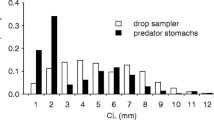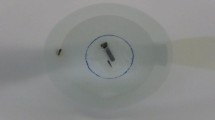Synopsis
The vulnerability of white perch, Morone americana, larvae to yearling bluegill, Lepomis macrochira, predators was examined in relation to larval size, nutritional condition and relative abundance of alternative prey. Short-term (15 min) predation trials were conducted in 381 tanks in the laboratory. Larval vulnerability was measured as the proportion of larvae killed and the proportion of successful attacks per predator in each 15 min trial. No significant differences in vulnerability were apparent among larvae regardless of feeding history at sizes < 6 mm SL. At larval lengths > 6 mm SL, size of larvae was the crucial determinant of their vulnerability. Percentage of larvae killed in 15 min was nearly 100% at sizes < 6 mm SL, decreased to 30% at a length of 12.0 mm SL and dropped to 18% at 14.0 mm SL. Larvae initially feeding at low food levels for 2–4 d exhibited decreased growth of 13–25% over the first 3 wks of life, and simulations based on laboratory results indicated that these growth deficits could result in 5- to 68-fold decreases in survivorship at 38 days after hatching (DAH). The relative abundance of alternative prey also had a pronounced effect on mortality of larvae. A 10-fold increase in alternative prey (Daphnia magna) abundance decreased bluegill predation rates on white perch larvae by 10–20%, while a 100-fold increase in Daphnia density decreased larval mortality by 75–90%.
Similar content being viewed by others
References cited
Bailey, K.M. & E.D. Houde. 1989. Predation on eggs and larvae of marine fishes and the recruitment problem. Adv. Mar. Biol. 25: 1–83.
Batty, R.S. 1984. Development of the swimming movements and musculature of larval herring (Clupea harengus). J. Exp. Biol. 110: 217–229.
Beyer, J.E. & G.C. Laurence. 1981. Modelling growth and mortality of larval herring (Clupea harengus). Rapp. P.-v. Reun. Cons. int. Explor. Mer 178: 17–23.
Blaxter, J.H.S. 1986. Development of sense organs and behavior of teleost larvae with special reference to feeding and predator avoidance. Trans. Amer. Fish. Soc. 115: 98–114.
Breitburg, D.L. 1988. Effects of turbidity on prey consumption by striped bass larvae. Trans. Amer. Fish. Soc. 117: 72–77.
Brownell, C.L. 1985. Laboratory analysis of cannibalism by larvae of the Cape anchovy Engraulis capensis. Trans. Amer. Fish. Soc. 114: 512–518.
Carlander, K. D. 1977. Handbook of freshwater fishery biology, Vol. 2. Iowa State University Press, Ames. 431 pp.
Crowder, L.B. 1985. Optimal foraging and feeding mode shifts in fishes. Env. Biol. Fish. 12: 57–62.
Cushing, D.H. 1975. Marine ecology and fisheries. Cambridge University Press, London. 278 pp.
Cushing, D.H. 1981. Fisheries biology, a study in population dynamics. University of Wisconsin Press, Madison, 295 pp.
de Lafontaine, Y. & W.C. Leggett. 1987. Effect of container size on estimates of mortality and predation rates in experiments with macrozooplankton and larval fish. Can. J. Fish. Aquat. Sci. 44: 1534–1543.
Dowd, C.E. 1986. Predator-prey interactions between juvenile bay anchovy (Anchoa mitchilli) and larvae of the sea bream (Archosargus rhomboidahs). Ph.D. Thesis, University of Miami, Miami. 133 pp.
Folkvord, A. & J.R. Hunter. 1986. Size-specific vulnerability of northern anchovy Engraulis mordax larvae to predation by fishes. U.S. Fish. Bull. 84: 859–869.
Fuiman, L.A. 1989. Vulnerability of Atlantic herring larvae to predation by yearling herring. Mar. Ecol. Prog. Ser. 51: 291–299.
Heinle, D.R. & D.A. Flemer. 1975. Carbon requirements of a population of the estuarine copepod Eurytemora affinis. Mar. Biol. (Berl.) 31: 235–247.
Houde, E.D. 1978. Critical food concentrations for larvae of three species of subtropical marine fishes. Bull. Mar. Sci. 28: 395–411.
Houde, E.D. 1987. Fish early life dynamics and recruitment variability. Amer. Fish. Soc. Symposium 2: 17–29.
Hunter, J.R. 1981. Feeding ecology and predation of marine fish larvae. pp. 287–330. In: R. Lasker (ed.) Marine Fish Larvae, Morphology, Ecology and Relation to Fisheries, University of Washington Press, Seattle.
Hunter, J.R. 1982. Predation and recruitment. pp. 172–209. In: B.J. Rothschild & C. Rooth (ed.) Fish Ecology III, A Foundation for REX, a Recruitment Experiment, University of Miami Tech. Rep. No. 82008.
Hunter, J.R. 1984. Inferences regarding predation on the early life stages of cod and other fishes. pp. 533–562. In: E. Dahl, D.S. Danielssen, E. Moksness & P. Solemdal (ed.) The Propogation of Cod Gadus morhua L., Flodevigen rapportser. 1.
Gardner, M.B. 1981. Mechanisms of size selectivity by planktivorous fish: a test of hypotheses. Ecology 62: 571–578.
Jones, R. 1973. Density dependent regulation of the numbers of cod and haddock. Rapp. P.-v. Reun. Cons. int. Explor. Mer 164: 156–173.
Lasker, R. 1978. The relation between oceanographic conditions and larval anchovy food in the California Current: identification of factors contributing to recruitment failure. Rapp. P.-v. Reun. Cons. int. Explor. Mer 173: 212–230.
Lippson, A.J., M.S. Haire, A.F. Holland, F. Jacobs, J. Jensen, R.L. Moran-Johnson, T.T. Polgar & W.A. Richkus. 1980. Environmental atlas of the Potomac estuary. Environmental Center, Martin Marietta Corporation, Baltimore. 135 pp.
Margulies, D. 1986. Effects of food concentration and temperature on development, growth, survival and susceptibility to predation of larval white perch (Morone americana). Ph.D. Thesis, University of Maryland, College Park. 168 pp.
Margulies, D. 1989a. Effects of food concentration and temperature on development, growth and survival of white perch, Morone americana, eggs and larvae. U.S. Fish. Bull. 87: 63–72.
Margulies, D. 1989b. Size-specific vulnerability to predation and sensory system development of white seabass, Atractoscion nobilis, larvae. U.S. Fish. Bull. 87 (in press).
Martin, F.D. & E. Setzler-Hamilton. 1983. Assessment of larval striped bass stocks in the Potomac Estuary, a final report for years 1980, :1981, and 1982. University of Maryland Center for Environmental and Estuarine Studies, Chesapeake Biological Laboratory, Solomons, UMCEES 83-55-CBL.
McGovern, J.C. & J.E. Olney. 1988. Potential predation by fish and invertebrates on early life history stages of striped bass in the Pamunkey River, Virginia. Trans Amer. Fish. Soc. 117: 152–161.
Miller, R.J., L.B. Crowder, J.A. Rice & E.A. Marschali. 1988. Larval size and recruitment mechanisms in fishes: toward a conceptual framework. Can. J. Fish. Aquat. Sci. 45: 1657–1670.
Neave, D.A. 1984. The development of visual acuity in larval plaice (Pleuronectes platessa L.) and turbot (Scophthalmus maximus L.). J. Exp. Mar. Biol. Ecol. 78: 167–175.
O'Brien, W.J., B.I. Evans & G.L. Howick, 1986. A new view of the predation cycle of a planktivorous fish, white crappie (Pomoxis annularis). Can. J. Fish. Aquat. Sci. 43: 1894–1899.
Rice, J.A., L.B. Crowder & F.P. Binkowski. 1987. Evaluating potential sources of mortality for larval bloater (Coregonus hoyi): starvation and vulnerability to predation. Can. J. Fish. Aquat. Sci. 44: 467–472.
Ricker, W.E. 1975. Computation and interpretation of biological statistics of fish populations. Fish. Res. Board Can. Bull. 191. 382 pp.
Sarker, A.L. 1977. Feeding ecology of the bluegill, Lepomis macrochirus, in two heated reservoirs of Texas, III, Time of day and patterns of feeding. Trans. Amer. Fish. Soc. 106: 596–601.
SAS (Statistical Analysis System). 1982. SAS user's guide: statistics. SAS Institute, Cary, N.C.
Shepherd, J.G. & D.H. Cushing. 1980. A mechanism for density-dependent survival of larval fish as the basis of a stockrecruitment relationship. J. Cons. int. Explor. Mer 39: 160–167.
Sinclair, M. & T.D. Iles. 1985. Atlantic herring (Clupea harengus) distributions in the Gulf of Maine-Scotian Shelf area in relation to oceanographic features. Can. J. Fish. Aquat. Sci. 42: 880–887.
Smith, R.E. & R.J. Kernehan. 1981. Predation by the free-living copepod, Cyclops bicuspidatus thomasi, on larvae of the striped bass and white perch. Estuaries 4: 81–83.
Strauss, R.E. 1979. Reliability estimates for Ivlev's electivity index, the forage ratio, and a proposed linear index of food selection. Trans. Amer. Fish. Soc. 108: 344–352.
Vinyard, G.L. 1980. Differential prey vulnerability and predator selectivity: effects of evasive prey on bluegil (Lepomis macrochirus) and pumpkinseed (L. gibbosus) predation. Can. J. Fish. Aquat. Sci. 37: 2294–2299.
Vinyard, G.L. & W.J. O'Brien. 1976. Effects of light and turbidity on the reactive distance of bluegill (Lepomis macrochirus). J. Fish. Res. Board Can. 33: 2845–2849.
Webb, P.W. 1981. Responses of northern anchovy, Engraulis mordax larvae to predation by a biting planktivore, Amphiprion percula. U.S. Fish. Bull. 79: 727–735.
Werner, E.E. 1974. The fish size, prey size, handling time relation in several sunfishes and some implications. J. Fish. Res. Board Can. 31: 1531–1536.
Werner, E.E. & J.F. Gilliam. 1984. The ontogenetic niche and species interactions in size-structured populations. Ann. Rev. Ecol. Syst. 15: 393–425.
Werner, E.E., J.F. Gilliam, D.J. Hall & G.G. Mittelbach. 1983. An experimental test of the effects of predation risk on habitat use in fish. Ecology 64: 1540–1548.
Zaret, T.M. 1980. Predation and freshwater communities. Yale University Press, New Haven. 187 pp.
Author information
Authors and Affiliations
Rights and permissions
About this article
Cite this article
Margulies, D. Vulnerability of larval white perch, Morone americana, to fish predation. Environ Biol Fish 27, 187–200 (1990). https://doi.org/10.1007/BF00001672
Received:
Accepted:
Issue Date:
DOI: https://doi.org/10.1007/BF00001672




